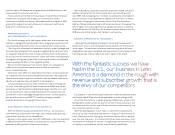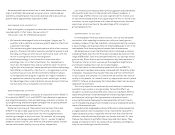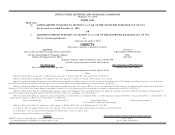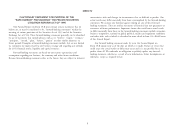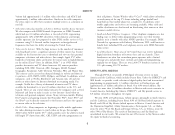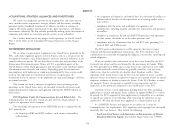DIRECTV 2010 Annual Report Download - page 28
Download and view the complete annual report
Please find page 28 of the 2010 DIRECTV annual report below. You can navigate through the pages in the report by either clicking on the pages listed below, or by using the keyword search tool below to find specific information within the annual report.DIRECTV
cable industry, we have not had the ability to target advertising at the • Obtain rights for new value-added video services such as rights to
local level due to the nature of our national satellite infrastructure. offer our customers 3D, mobile and streaming services.
Using new technology, which we expect will be available in 2011, we • Repackage channels to better align the programming that our
will have the capability to insert ads into individual DVR set-top customers want to watch with what they are willing to pay for.
receivers to enable advertisers to target customers in local regions and
eventually in the individual home. With this new technology, we • Drop less popular channels if we are unable to negotiate fair terms
expect to significantly increase our advertising revenues over the and conditions.
coming years. •Capture Enterprise-Wide Productivity Improvements. Our objective is to
•Deliver New Products Focused on Priority Commercial Segments. Based deliver the best video experience at the lowest possible cost. We
on our extremely low market penetration rates, we believe commercial endeavor to manage our costs and in particular to capture productivity
properties represent another growth opportunity for DIRECTV. For improvements which will not only reduce costs, but also improve
example, although historically we have competed effectively in the customer service.
higher-end hotel market, we expect that in the coming years, hotels
will be upgrading their television service from standard definition to Infrastructure
HD, which should present us with opportunities for growth. We also Satellites. We currently have a fleet of twelve geosynchronous satellites,
currently have low market share in the private businesses and smaller including eleven owned satellites and one leased satellite. We have seven Ku-Band
bars and restaurants segments and we intend to grow our share in these satellites at the following orbital locations: 101⬚ WL (three), 110⬚ WL (one),
markets with new technologies such as digital signage, as well as from 119⬚ WL (one), 72.5⬚ WL (one), and 95⬚ WL (one-leased). We also have five
improved management, targeting, billing, pricing and packaging. Ka-Band satellites at our 99⬚ WL (two) and 103⬚ WL (three) orbital locations. The
•Enhance Productivity and Manage Costs. Improving our productivity is a 72.5⬚ WL orbital location is used pursuant to an arrangement with Telesat Canada
critical element of our goal to maintain strong margins particularly given the and Bell ExpressVu.
competitive nature of our industry and rising programming costs. In We have contracted for the construction of an additional satellite to provide
particular, we plan to focus our efforts on effectively managing our additional services as well as backup capacity, which we expect to launch and place
programming costs and capturing enterprise-wide productivity into service in 2013.
improvements.
Satellite Risk Management. At times, we use launch and in-orbit insurance
•Strategically Manage Content Cost Growth. Content costs are to mitigate the potential financial impact of satellite fleet launch and in-orbit
DIRECTV’s largest expense and as a result, we must manage these failures unless the premium costs are considered to be uneconomical relative to the
costs as effectively as possible particularly considering that we expect risk of satellite failure. The insurance generally does not compensate for business
programming costs to increase at a faster rate in the future than in interruption or loss of future revenues or subscribers. We rely on in-orbit spare
prior years primarily due to higher sports costs (including the NFL satellites and excess transponder capacity at key orbital slots to mitigate the impact
Sunday Ticket) and higher retransmission fees for the carriage of local of a potential satellite failure on our ability to provide service. However,
channels. Our strategy for minimizing this rate of cost growth is to: programming continuity cannot be assured in all instances or in the event of
• Leverage our size, growth and attractive subscriber demographics multiple satellite losses.
to attain competitive terms and conditions. Launch insurance typically covers the time frame from ignition of the launch
• More closely align a channel’s ratings with the costs we pay. vehicle through separation of the satellite from the launch vehicle. In the past, we
6


